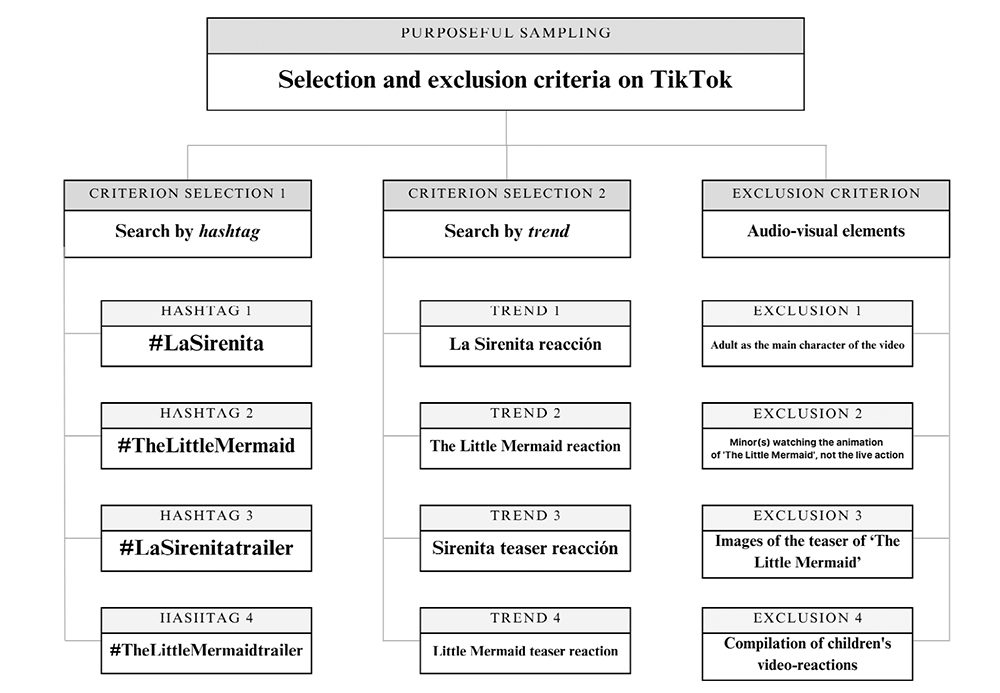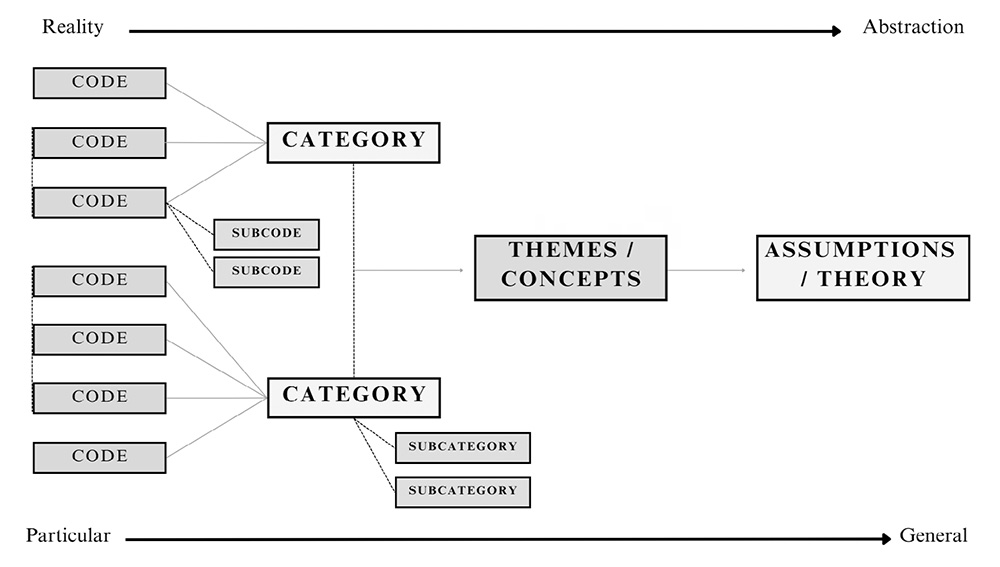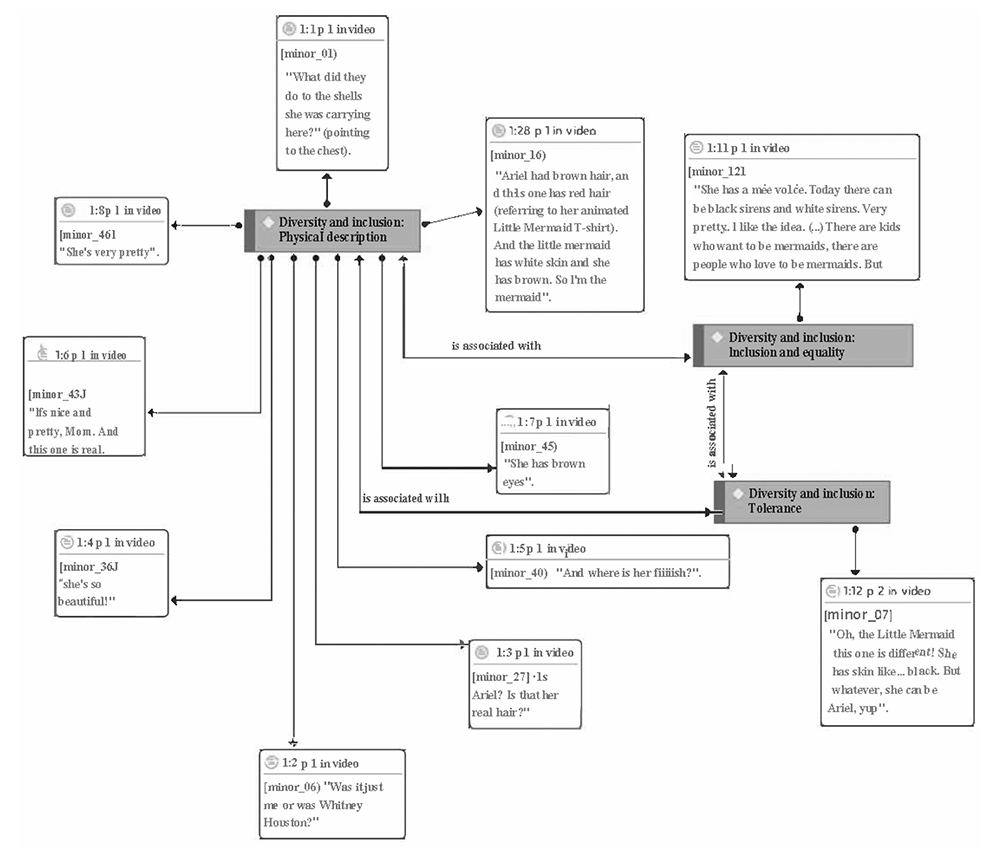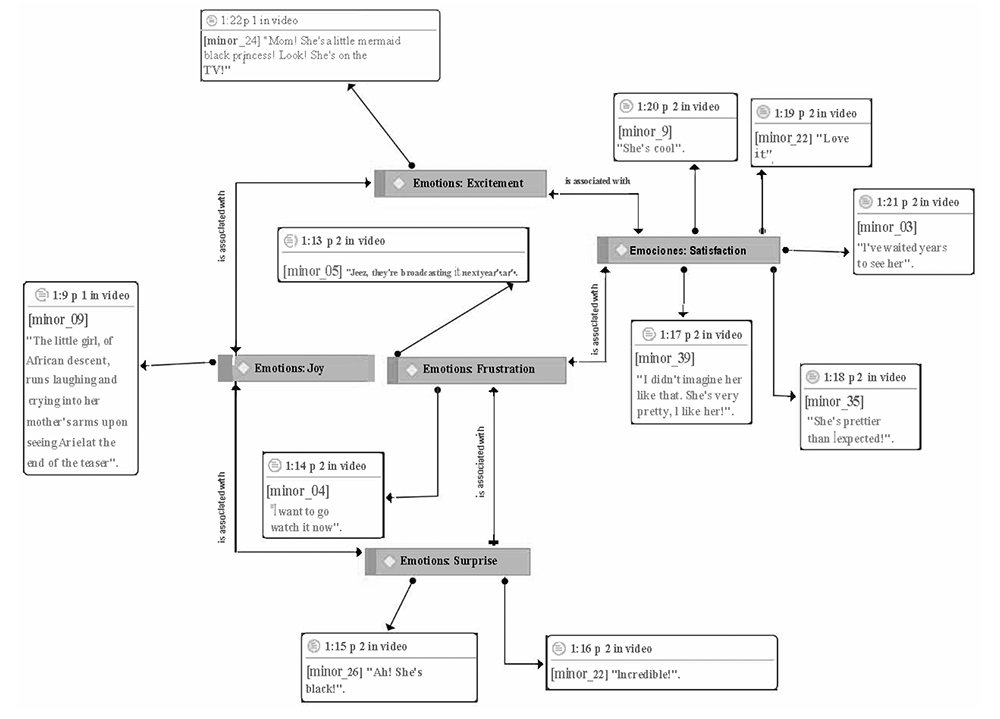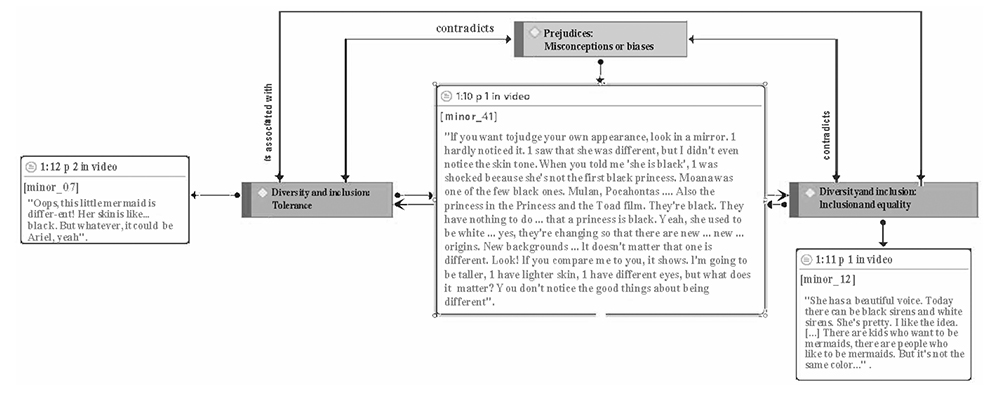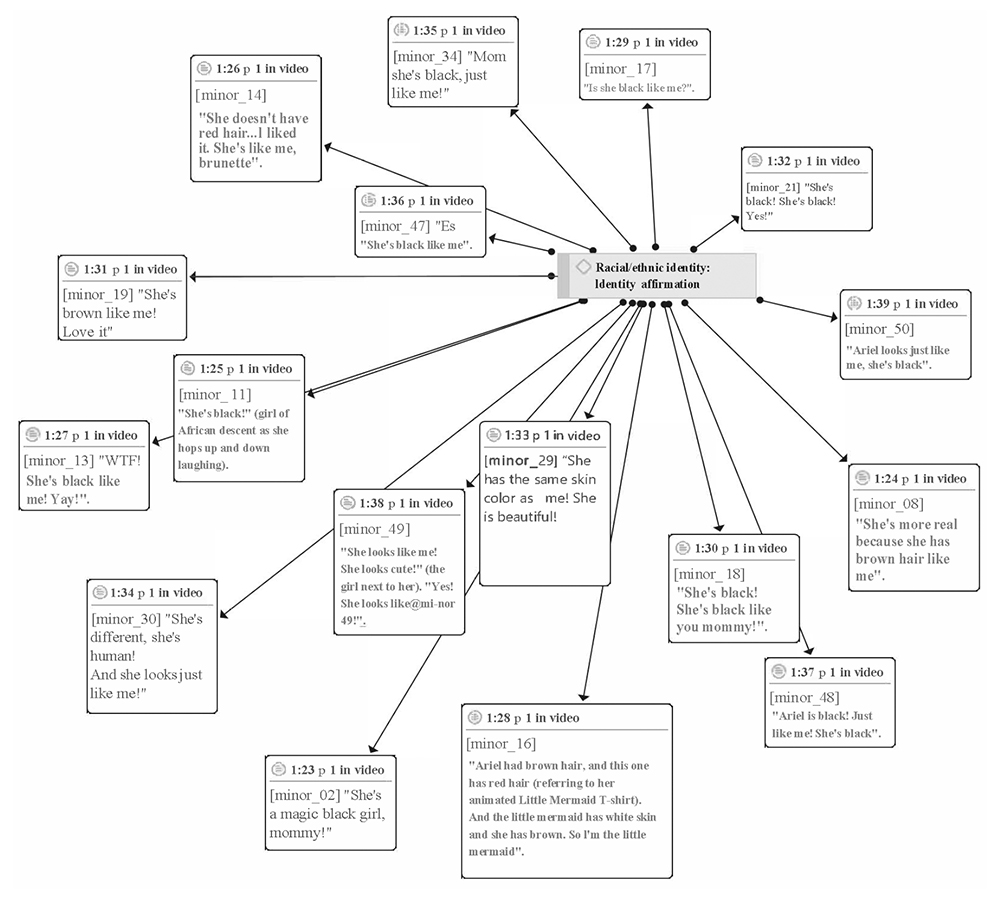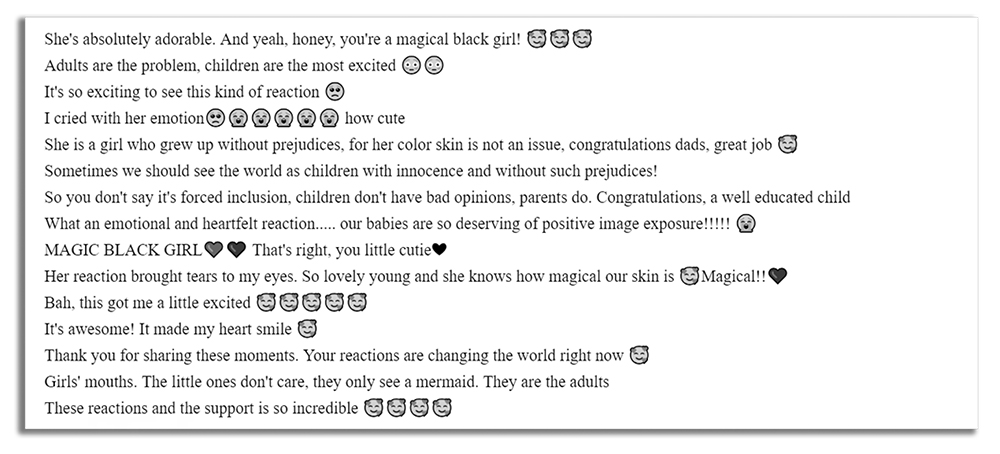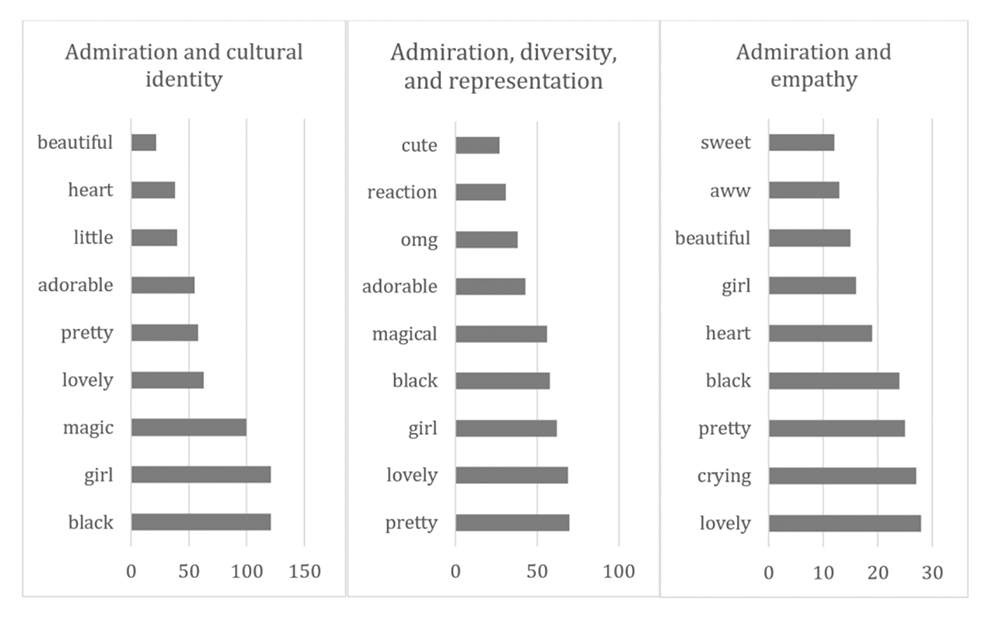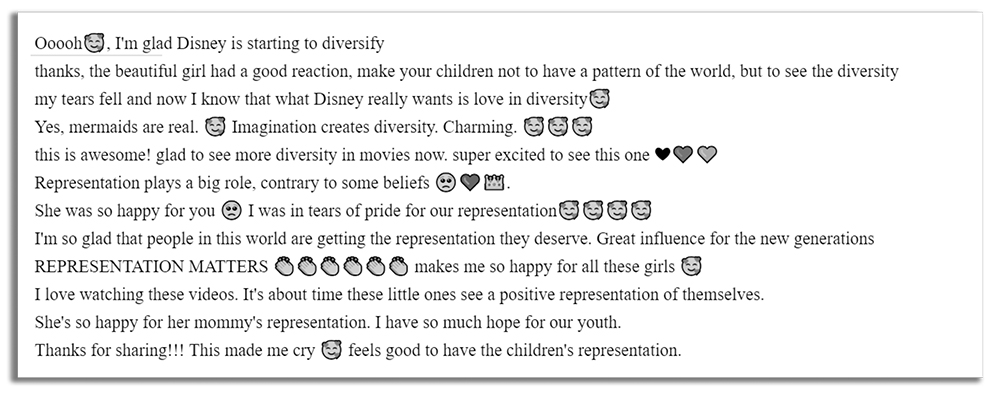Mi SciELO
Servicios Personalizados
Revista
Articulo
Indicadores
-
 Citado por SciELO
Citado por SciELO -
 Accesos
Accesos
Links relacionados
-
 Citado por Google
Citado por Google -
 Similares en
SciELO
Similares en
SciELO -
 Similares en Google
Similares en Google
Compartir
Psychology, Society & Education
versión On-line ISSN 1989-709X
Psychology, Society & Education vol.15 no.3 Córdoba sep./dic. 2023 Epub 18-Mar-2024
https://dx.doi.org/10.21071/psye.v15i3.16098
Articles
“The Little Mermaid looks like me!”: cross-cultural diversity, inclusion and children's self-esteem on TikTok
1 Universidad Europea del Atlántico, Santander (Spain)
2 Universidad Internacional de la Rioja, Madrid (Spain)
While media raise awareness about inclusion and cross-cultural diversity worldwide, new avenues for debate are emerging in social media platforms such as TikTok, targeting especially children's audiences. An example of this are the popular reaction videos to film releases such as the teaser of Disney's The Little Mermaid live action, which have constructed discussion networks around symbolic representation, colonial decentralization, stereotypical rupture, or the Caucasian imaginary in childhood. This study examines children's reactions and community sentiment expressed on TikTok through qualitative analysis of 50 video-reactions and sentiment analysis of 11,510 comments. For this purpose, we conducted an inductive content analysis using 10 codes, including “diversity and inclusion”, “emotions”, “prejudice”, and “racial/ethnic identity”, as well as a sentiment analysis coded using natural language processing and artificial intelligence based on OpenAI's GPT model. The findings indicate that the portrayal of an African-American character, Halle Bailey, is well-received by minors, fostering a widespread positive response towards cross-cultural diversity. The representation of a black complexion and copper-brown hair, in contrast to the former Caucasian and red-haired icon, does not appear to intimidate children, who express enthusiasm and excitement about her role. This representation reflects a sense of shared positivism, where both the adult and child “Disneyfied” imagination suggest a future based on diversity and enhanced self-esteem for children.
Keywords: Inclusion; Social media; Disney; Childhood; Stereotypes
Currently, mass media, particularly children's cinema, has a significant impact on the identity development of child audiences. Minors are exposed from an early age to a large volume of audio-visual content, which contributes to the shaping of sociocultural norms by conveying attitudes, values, and belief systems (Kniaziuk & Sennikova, 2022). In addition, animated films also serve as reference standards for children in terms of socio-cognitive development, as their characters, stories, and stereotypes particularly influence them (Neira-Pineiro et al., 2021). Thus, children might feel identified and experience emotional bonds with characters, even developing parasocial relationships, imitating behaviors, or comparing what they see in the media to the interactions that occur in real life (Zurcher et al., 2018).
Historically, most films, whether literary or audio-visual, have been created (and continue to be created) by writers and artists belonging to “white, Eurocentric cultures” (Bradford, 2007). Therefore, representations of fictional characters are rooted in their practices, perspectives, and storytelling traditions. Similarly, the historical, political, cultural, and social context of each era can influence the messages in the construction of the audience's mindset (Monleón, 2018). This research aims to delve into the debate generated on TikTok due to the casting of Halle Bailey, an African-American actress, singer, and songwriter, as the lead in the live-action adaptation of The Little Mermaid. Specifically, we analyze children's reactions to the film teaser and explore the community sentiment expressed on TikTok to further examine the discussion on cross-cultural inclusion and diversity within Disney film projects.
Theoretical framework
Cross-culturalism, diversity, and stereotypes at Disney
From its origins, the film industry has been a communication vehicle with the capacity to reach across generations through its stories, content, and values, as it is not only considered a form of entertainment but also a major contributor to popular culture (Martinez-Salanova-Sanchez, 2003).
Disney has positioned itself as a leader in this industry, providing a wide range of content to entertain children's audiences (Zurcher et al., 2018). Its animated films continue to be highly influential communication format, contributing to the education of beliefs and values (Vizcaíno-Verdú et al., 2020), given their ubiquitous nature and globally widespread consumption (Holcomb et al., 2015). Thus, we should address how these media outputs can be influential in the development of children's identities (Van-Wormer et al., 2015).
Many cultural minority families engage in co-watching audio-visual content targeted to children as a way to spend time together and learn about their ethnic identity, which is a common practice among Latino families in the United States (Walsh & Azmitia, 2022; Zhao & Phillips, 2013). This allows them to connect with their culture of origin and construct narratives around their family identity (Walsh & Azmitia, 2022). Throughout middle childhood, media socialization becomes particularly significant, notably for the development of children's ethnic identity, as they gradually develop a more complex understanding of concepts such as “race” and “ethnicity” and internalize cultural values and practices related to their self-identity (Derlan et al., 2016).
Certainly, the “Princesses” epitomize prominent identity traits in Disney films (Tyner-Mullings, 2023) and have evolved into cultural symbols over multiple generations, serving as idealized emblems of female childhood (Golden & Wallace, 2018). However, the company has been evolving its portrayal of female characters to align with societal shifts and contemporary trends (Sanchez-Gil, 2023). Perera-Santana and Bautista-García (2019) contend that traditional princesses (e.g., Snow White, Cinderella, Aurora, Ariel…), known for their beauty, kindness, naivety, delicacy, and submissiveness, have given rise to novel portrayals that diverge from heteronormative romanticization. Characters like Pocahontas, Mulan, Tiana, Moana, and Elsa, among others, exemplify a significant and progressive transformation of “femininity” (Muir, 2023) in terms of personality, decision-making, and the ability to challenge conventional familial and social assumptions. Moreover, they exhibit increased diversity (no longer exclusively Caucasian); however, stereotypes related to their beauty, aesthetics, and exotic portrayal persist (Perera-Santana & Bautista-García, 2019). Nonetheless, their racial and sociocultural diversity reflects the producer's commitment to fostering a more cross-cultural representational framework (Walsh & Azmitia, 2022).
In contrast to the original “Disney princesses”, who awaited male rescue, contemporary female characters face challenges, demonstrate nonconformity, and cultivate their self-esteem, abandoning the marriage archetype in favor of exploring other facets of life (Averbach, 2003; Perera-Santana & Bautista-García, 2019). Consequently, this transformation of female characters amplifies the prominence, diversity, and empowerment of women's roles in animated films (Neira-Piñeiro et al., 2021).
Nonetheless, there is also evidence supporting the significance of classic tales originating from oral traditions, catering to both younger and older generations. By reinterpreting and reimagining characters and narratives within the framework of contemporary social and cultural contexts, these stories promote female empowerment (Pedreira & Ferreira-Boo, 2022). Furthermore, in recent years, the company has demonstrated its dedication to producing live-action adaptations (films portraying characters and elements from Disney's original animated films in real-life settings) of Disney's timeless classics.
As per García-Jiménez (2022), the initial live-action films primarily consisted of remakes (adaptations or recreations) of their animated predecessors. Conversely, the films released since 2017 have strived to faithfully mirror the classic animated films in terms of both content and scenography, earning them the classification of “audio-visual retellings” tailored for children, adolescents, and adults alike. In this context, we can discern three methods for producing live-action films, notably influenced by economic and commercial considerations (García-Jiménez, 2022): (1) leveraging technology to meticulously replicate the original animation, making it readily recognizable to viewers, especially adults; (2) enlisting a typically renowned director to infuse the film with their distinctive cinematic style, adding elements of innovation; (3) incorporating new social values through the “(re)construction of certain characters” to modernize the classic film from ideological, moral, and educational standpoints.
Although the classic animated film The Little Mermaid was released in 1989, it has spawned a community of dedicated enthusiasts that continues to the present (Vermaak-Griessel, 2022), and it has now been adapted into a live-action version, which premiered in May 2023. In this context, given that Disney films have shaped the aesthetic and ideological upbringing of various generations (Perera-Santana & Bautista-García, 2019), this study delves into the viral reactions on TikTok as children encounter the teaser for Disney's live-action adaptation of The Little Mermaid. Consequently, the decision to cast Halle Bailey, an actress of African-American descent, as the lead in this new film adaptation, has ignited a substantial media discourse (BBC News, 2022; Meyerowitz, 2022), sparking debates among audiences regarding issues of inclusion, race, and ethnic representation. In light of this ongoing discourse, it is worth highlighting that in earlier adaptations of the classic, the character Ursula, the story's antagonist, had previously been portrayed by a black actress -for instance, in the ABC series Once Upon a Time, specifically, by the American actress Merrin Dungey. However, this fact did not incite significant controversy or outrage at the time, as the fan community appeared to embrace this aspect of the character (Scott & Paprocki, 2023).
This study also delves into the overall sentiments of TikTok users concerning the influence of this film adaptation, particularly concerning the central character of the narrative. This matter addresses a timely and substantial societal discourse, as it pertains to ethnic representation within entertainment media primarily aimed at a childish demographic but also inclusive of adult viewers. Consequently, it stimulates societal and cultural contemplation regarding a teaser that introduces noteworthy alterations in the portrayal of an iconic character, such as The Little Mermaid.
Method
To delve deeper into the discourse on cross-cultural diversity and inclusion sparked by the live-action adaptation of The Little Mermaid on TikTok, we employed a mixed qualitative methodology. Specifically, we employed two research methods, outlined in the subsequent sections. Initially, we conducted an inductive content analysis of children's video-reactions to the initial teaser. Subsequently, we scrutinized the comments elicited by these children's reactions using a quantitative-qualitative sentiment analysis.
In this context, the research questions that informed the methodological approach and its subsequent analysis encompassed the following inquiries: (RQ1) What are the children's reactions to the teaser of The Little Mermaid live-action adaptation?; and (RQ2) What is the predominant community sentiment regarding children's responses to Halle Bailey's portrayal in The Little Mermaid live-action adaptation?
First sample: children's video-reactions
The study's sample comprises video-reactions from children, as shared by relatives of minors on TikTok, who are witnessing the teaser for the live-action adaptation of The Little Mermaid, released in September 2022, for the first time. These posts were specifically selected due to the media impact of this trend (BBC News, 2022; Meyerowitz, 2022), which featured multiple instances of children reacting to Ariel's portrayal by Halle Bailey during that month.
Given their intricate nature, we categorized these videos through purposeful sampling and selection criteria (Palys, 2008). This procedure facilitated the inclusion of significant posts, allowing us to examine the phenomenon from a child-centric perspective (RQ1), employing hashtag and trend-based searches (Figure 1).
In January 2023, we manually gathered 50 videos featuring reactions in both Spanish and English. Furthermore, to guarantee the privacy and confidentiality of the minors featured in these posts, we opted to anonymize their data during the subsequent analysis. This was achieved by assigning pseudonyms to their contributions and safeguarding the downloaded data (ERIC, 2023).
Second sample: comments to video-reactions
To analyze the community sentiment surrounding these video-reactions, we gathered comments from the posts. To do so, we employed the web scraping technique, which involves the extensive extraction of data and information from a website or digital platform (Mitchell, 2018). Notably, we utilized the Node Package Manager (NPM) as the unofficial TikTok API manager within the JavaScript framework Node.js 20. In March 2023, we input the IDs of each video into the system, amassing a total of 13,301 comments.
Upon reviewing the compilation, we identified comments that did not contribute to the corresponding methodology (quantitative-qualitative sentiment analysis). We excluded comments that included: (1) exclusive codes (emoji) and illegible spelling; (2) exclusive mentions of other users (tags with @). The final sample consisted of 11,510 comments (accessible at https://doi.org/10.6084/m9.figshare.22674814). To process the data, we fully translated comments identified in English, French, Spanish, Greek, Japanese, Russian, Thai, and Vietnamese into English using the TextBlob library with the Python programming language.
Research techniques
First technique: inductive codification
To comprehend the influence of the teaser on children, particularly their response to the alteration in the appearance of the main character, we employed an inductive content analysis. This approach entails the interpretation of data derived from a unit of analysis (in this instance, video-reactions). The review and examination of these reactions aid in grasping the nuances of meanings, issues, and interactions (Vears & Gillam, 2022) via a methodical coding process (Figure 2).
The procedure entailed the identification of patterns within the video-reactions, specifically regarding the physical description of Ariel. Subsequently, we defined categories to characterize these patterns, consolidating the physical description into a category labeled “diversity and inclusion”. This categorization was prompted by the inclusive discourse observed among the children when they identified themselves represented on the screen. These categories served as a foundation for establishing conceptual themes that facilitated the subsequent findings. Notably, in this case, the children appeared to endorse cross-cultural equality and tolerance. We conducted the data analysis encompassing codes, categories, concepts, and insights into children's reactions using the content analysis software Atlas.ti 23.
Second technique: sentiment analysis, coding, and statistical testing
The substantial volume of comments earmarked for analysis required a system to streamline the extraction of collective sentiment regarding the Halle Bailey as Ariel controversy. In this instance, we utilized the TextBlob library via a Python script within the PyCharm development environment to conduct a “sentiment analysis”. This Big Data technique, encompassing computational science, computational linguistics, data mining, psychology, and sociology, aids in broadly discerning the emotional tenor of a group's sentiments (expressed through linguistic means) via natural language processing. It thereby indicates the polarity, signifying the level of positivity and negativity within a text (Taboada, 2016). To delve deeper into the overall sentiment analysis, we automated the coding of the 11,510 comments using the AI Coding system (artificial intelligence coding), leveraging the Generative Pre-trained Transformer (GPT) model developed by OpenAI within the Atlas.ti 23 software. Subsequently, we interpreted the resulting codes through the application of chi-square and Cramer's V statistical tests using SPSS v.25.
Findings
RQ1: Children's reactions to the “real” Ariel
After analyzing the video-reactions of the children to the teaser, we identified four categories (“diversity and inclusion”, “emotions”, “prejudice”, and “racial/ethnic identity”) and their corresponding codes (10 in total). These categories helped us address the first research question, concerning how children respond to the alteration in the appearance of a classic Disney princess.
Diversity and inclusion: growth descriptions, equality, and tolerance
In the first category, we observed up to three codes based on the physical reactions and responses of the children. The most frequent one pertained to Ariel's “physical description”, discovered at the end of the teaser. As shown in Figure 3, the children raised minimal concerns about the mermaid's appearance (eye color, chest shells, or the absence of complementary characters like her “fish” -Flounder).
Others praised her appearance, describing Ariel as “pretty”, “cute”, or “beautiful”. Additionally, some were impressed by what appeared to be the “real Ariel”, i.e., the transformation of an animated character into a physical entity seemed to elicit their satisfaction and delight (they did not anticipate that the red-haired, Caucasian Ariel would have this ostensibly authentic appearance).
The remaining codes (“inclusion and equality”, and “tolerance”) alluded to the possibility of Ariel having Afro-descendant features. By considering minor_12's argument, we can discern that the selection of Halle Bailey implies a significant step forward in terms of inclusion and equality in cinematic representation. Any individual, regardless of their background, can aspire to portray any character within the film industry.
Disney's live-action adaptations manifest a clear intent to incorporate and convey new values that are attuned to contemporary society, particularly concerning feminism, sexual orientation, and, in this instance, ethnicity (García-Jiménez, 2022; Muir, 2023). Consequently, the selection of this actress serves as an indication that strides are being taken towards a more inclusive and intercultural society.
Conversely, minor_07 highlights that the actress's physical appearance does not hinder her ability to portray her favorite princess. This demonstrates that character interpretation relies not solely on physical appearance but also on acting aptitude.
Emotions: jumping for joy and acceptance
Emotional expression constitutes a foundational component of human behavior, and its presentation can differ based on the individual and the context (Lorenzo-de-Reizábal, 2022). In the course of Ariel's introduction in the teaser, children conveyed their emotions through both physical and verbal means. Laughter, screams, tears, jumps, and applause served as tangible indicators of a genuine and unscripted reaction.
Some children fervently expressed their joy by running into the arms of their family members and shedding tears of happiness (minor_09). Others vocally exclaimed their fascination with the mermaid, describing her as “incredible”, “black”, or expressing surprise at her appearance on television (minor_22, minor_24, minor_26). Some conveyed their approval of an unexpected physical appearance (minor_03, minor_09, minor_22, minor_35, minor_39), while a few even expressed their frustration due to the seemingly endless wait for its release in theaters (minor_04, minor_05) (Figure 4).
The display of diverse emotions created a favorable context around Bailey's portrayal of Ariel. Thus, the depiction of diversity in widely consumed cultural contexts like the film industry, particularly those targeting children, appears to evoke profound, genuine, and respectful emotional reactions.
Prejudice: children do not judge
The commentary offered by minor_41, who is 9 years old, regarding social biases related to physical appearance, held significant importance, particularly concerning the portrayal of diversity in the film industry. Although most of the minors appeared or declared themselves to be under 4 years old (due to the overprinted texts or the comments of their relatives), minor_41 showed an outstanding capacity for reflection and analysis.
In their comment, minor_41 de-emphasized physical appearance and highlighted the importance of valuing diversity. This perspective showcases an open and respectful stance towards diversity, which is particularly vital in a context marked by enduring biases and stereotypes about physical appearance (Figure 5). Additionally, minor_41 referenced the actress's skin complexion to illustrate that other “Disney princesses” (Mulan, Pocahontas, Tiana, Moana…) hail from different origins, thereby promoting new ways of comprehending the world. This observation underscores the entertainment industry's capacity and influence in shaping the perceptions of its young audience (Perera-Santana & Bautista-García, 2019; Van-Wormer & Juby, 2015).
The prejudices, misconceptions, and controversies concerning the portrayal of Ariel in the live-action adaptation were associated with the realm of diversity and inclusion (embracing equality and tolerance). These issues highlight the imperative to nurture the well-being of all individuals, irrespective of their racial, ethnic, socio-educational, economic, or cultural backgrounds.
Identities and representativeness: “She looks like me!”
In concluding RQ1, it is noteworthy that children, particularly those of Latino or Afro-descendant heritage, expressed positive emotions when they could relate to and find representation in a historically Caucasian Disney character. The category of “racial/ethnic identity” and, specifically, “identity affirmation”, emerged as a recurrent theme in the analyzed discourse of the children (Figure 6).
The surprise and joy displayed by the children demonstrated their empathic ability to identify with others and underscored the significance of representation in these media settings. The incorporation of diverse characters appears to play a role in shaping a society that enables young audiences to witness the appreciation and respect of their experiences and cultures (Walsh & Azmitia, 2022). The evident positive influence on the perception of cross-cultural diversity, self-image, and self-esteem motivates an inclusive children's culture that celebrates the diversity and coexistence of identities.
RQ2: Community sentiments under debate
To address the second research question (RQ2), which sought to comprehend the collective sentiment within the community participating in the children's video-reactions, we conducted sentiment analysis on the 11,510 comments. We utilized a machine learning system that reads, identifies, and categorizes comments within a sentiment range of -1 (highly negative), 0 (neutral), and 1 (highly positive) to calculate the overall mean.
The overall community sentiment, as determined by artificial intelligence, yielded an average score of .28. In other words, users generally exhibited a notably positive sentiment towards the children's genuine, cross-cultural, and tolerant reaction to Ariel. To specify further, we gathered 8.7% of negative messages (n = 1,005), 28.7% of neutral messages (n = 3,303), and 62.6% of positive messages (n = 7,202).
To delve deeper into the discussion, we employed automatic coding through Atlas.ti 23 AI, refining a set of 8 categorical codes: admiration, self-esteem, discrimination, diversity and representation, empathy, empowerment, cultural identity, and racism and stereotypes. Subsequently, we subjected this data to co-occurrence testing in order to identify relationships between the codes, followed by a comprehensive analysis using chi-square and Cramer's V test in SPSS v.25.
Admiration for cultural identity and the media representation of diversity
Admiration is an emotion that manifests through the capacity to recognize and esteem the qualities, virtues, and accomplishments of an individual or entity. In cinema, it emerges “when the character and the spectator share the same cultural context in which these attributes are valued” (Aertsen, 2017, p. 113). This emotion particularly stood out in the comments associated with cultural identity, diversity and representation, and empathy.
Utilizing the chi-square statistical test to examine the co-occurring Atlas.ti 23 codes (hereinafter referred to as variables), and commencing with admiration and cultural identity, we identified χ2(11,510) = 8,333.062; p < .001, Cramer's V = .851. In this initial instance, we rejected the null hypothesis, discerning a highly significant association among the comments that expressed admiration for cultural identity.
Regarding admiration and diversity and representation, we calculated that χ2(11,510) = 8,195.586; p < .001, Cramer's V = .844. Once more, we discerned a highly significant correlation between these two variables. Similarly, in the case of admiration and empathy, the test revealed a notably strong and significant association (χ2(11,510) = 4,392.747; p < .001, Cramer's V = .618).
This data revealed that amidst the moderate positivity evident in the comments, users expressed admiration for the concepts of cultural identity, diversity, and media representation, all while displaying a strong sense of empathy towards the children's reactions (Figure 7).
Similarly, we pinpointed the most prevalent terms among the three dependent variables, emphasizing concepts such as “precious”, “girl”, “black”, or “love” (Figure 8).
Diversity, inclusion, and cross-cultural empowerment promoting children's self-esteem
Diversity and cross-cultural inclusion pertain to the appreciation and acceptance of diverse cultural and ethnic identities (Aguado-Odina, 2004), as well as the promotion of equitable opportunities and societal participation (Newsinger & Eikhof, 2020), regardless of cultural disparities.
In this context, both the variables of diversity and representation, as well as those of cultural identity and empowerment, exhibited direct correlations with self-esteem, defined as the psychological construct encompassing an individual's self-evaluation and perception (Reina et al., 2010) across various aspects of their life (physical appearance, social skills, competencies…).
We identified a significant and moderate relationship between self-esteem and diversity and representation (χ2(11,510) = 1,782.221; p < .001, Cramer's V = .393). In other words, according to users, Afro-descendant media representation in a Disney feature film appears to have a notable impact on children's self-esteem. Furthermore, we observed a significantly moderate relationship between self-esteem and cultural identity (χ2(11,510) = 1,978.638; p < .001, Cramer's V = .415), highlighting the importance of ethnic recognition in the process of valuing the child's self and us concept.
Lastly, the findings concerning self-esteem and empowerment (χ2(11,510) = 1,190.442; p < .001, Cramer's V = .322) suggest a significantly moderate relationship between self-esteem and child empowerment. In other words, the comments suggest that media representation of diverse cultural identities, including Afro-descendant representation, may influence children's self-esteem (Figure 9).
Racism, stereotypes, and discrimination against cross-cultural diversity
Within the 1,005 negative messages, we examined the connections between the variables of discrimination (defined in social terms as the practice of treating an individual or group unfairly or unfavorably based on attributes such as race, gender, sexual orientation, religion, age, disability, etc.) and their associations with racism, stereotypes, and cultural identity.
To begin, we observed a significant and robust relationship between discrimination and racism and stereotypes (χ2(11,510) = 9,864.857; p < .001, Cramer's V = .926). This suggests that discriminatory comments may be closely associated with issues related to racism or stereotyping. Similarly, when examining the connection between discrimination and cultural identity, we found χ2(11,510) = 1,375.917; p< .001, Cramer's V = .346. While this data reveals a moderately significant relationship, the discussions around discrimination did not pertain to the cultural identity of the children or the main character in the film.
Notably, the comments took a particular approach in which, despite their defensive responses aimed at safeguarding their integrity in response to the message (in many cases explicitly stating that they were “not racist” or had “no intention to offend”), they adopted a confrontational and critical tone regarding what they perceived as a lack of genuine diversity or a sense of “forced inclusion”.
The comments contended that the issue revolves less around cross-cultural diversity or media representation of ethnicity among the children's audience and more around adhering to the standards previously established by Disney. This perspective is attributed to the heteronormative and historical trajectory of the company (Anjirbag, 2018; Monleón, 2018). In their view, if Ariel was originally portrayed as Caucasian and red-haired, there would be no apparent reason or logic to alter this aspect.
In this regard, the comments incited a debate surrounding two hypothetical scenarios: What would happen if Ariel's change had been reversed? Or what would occur if Disney produced a live-action version of Tiana with a Caucasian actress? (Figure 10).
Discussion and conclusions
Throughout its history, Disney has not only directed its films and characters towards entertainment but also towards moralization and education, crafting an iconic and globally recognized collective imagination (Tyner-Mullings, 2023; Van-Wormer & Juby, 2015; Zurcher et al., 2018). Disney's compilation of animated films known as “The Classics” (1937-2016) is often regarded as a cultural legacy targeted at children, although it is typically enjoyed by viewers of various age groups. However, this collection has historically displayed a tendency to favor Western norms while marginalizing or overlooking collectives with cross-cultural differences (Monleón, 2018).
Despite this longstanding representational tendency established by the company, which has been widely discussed (Anjirbag, 2018; Golden & Wallace, 2018; Van-Wormer & Juby, 2015), it seems important to acknowledge that major film companies have progressively introduced adaptations aimed at ethnic socialization (Walsh & Azmitia, 2022) to promote awareness of cultural colonialism, diversity, and representation (Anjirbag, 2018).
In recent years, Disney has endeavored to adapt to evolving social norms and values (Perera-Santana & Bautista-García, 2019), making deliberate efforts to avoid perpetuating racial and ethnic stereotypes (Zurcher et al., 2018). Consequently, in its most recent films, the company actively promotes diversity, taking steps to prevent the inclusion of sexist or xenophobic content that may have been present in its earlier releases. Furthermore, on its streaming platform Disney+, the company includes disclaimers before some of its classic titles, acknowledging the possibility of encountering offensive, racist, or discriminatory content (García-Jiménez, 2022).
In its commitment to this approach, the company has undertaken live-action adaptations and “audio-visual retellings” of some of its most successful animated films (García-Jiménez, 2022). These film productions have not been without controversy and criticism aimed at the company. A notable example is the live-action adaptation of Beauty and the Beast (Vizcaíno-Verdú et al., 2020), primarily due to its inclusion of a queer couple (Kunze, 2021). Similarly, the live-action adaptation of Mulan faced criticism for historical misrepresentation of Chinese culture and narratives, perpetuating stereotypes, and making unpopular changes in its adaptation (such as omitting songs or excluding iconic characters like Mushu) (Wang, 2022).
Even before their release, live-action adaptations spark debates and criticisms regarding racial and ethnic issues, particularly in relation to the casting of actors and actresses for main characters. Examples of such discussions can be seen in adaptations like The Little Mermaid, Peter Pan and Wendy, and Lilo and Stitch (Urra, 2023). A similar uproar occurred previously concerning the skin complexion of the Genie in Aladdin, portrayed by Will Smith, who is also of African-American descent. This controversy emerged when early leaks of the live-action adaptation did not depict the Genie with the characteristic blue tone associated with the animated character (Leisure Culture, 2019). These cases align with negative comments from users we analyzed, who expressed not a desire for hate speech or participation in racism but rather a yearning for faithful representation of the original characters they grew up with. Their concerns are tied to ideological, aesthetic, and nostalgic considerations.
In light of this controversy, our research delves into children's perceptions of these new films with the aim of shifting the debate toward Central European-American and Western decolonization. The findings indicate that children's reception of a female lead who deviates from the original character is notably positive and, unlike adults, this choice does not pose a problem or a cause for criticism of the film. In this context, we highlight the inclusive comments that express excitement and surprise at the opportunity to identify with Ariel in terms of physical appearance. In response to this sentiment, we underscore that cinematic cross-cultural representation involves the construction of diverse social and cultural realities and ideals for audiences, aligning with the concept of media decolonization (Anjirbag, 2018).
It is worth contemplating what holds more significance for Disney in social terms: 1) catering to adult audiences by creating new adaptations that closely adhere to the original films (with minor adjustments), or 2) aligning the films with the values of contemporary societies, demonstrating increased sensitivity to diversity encompassing race, ethnicity, gender roles, and sexual orientation. The preponderance of positive comments seems to endorse the second option. Consequently, users exhibit a positive inclination towards and appreciation for the need for inclusive and respectful portrayal of cross-cultural diversity in children's media productions. This, in turn, facilitates the development of a society for future generations grounded in self-esteem, admiration, and empowerment, potentially bolstering their cross-cultural identities.
One limitation of this study to acknowledge is the choice of a single Disney live-action film for analyzing children's reactions. The ongoing controversy and its media significance point to the need for future research to explore the direction of other debates -for instance, examining cases like Peter Pan and Wendy or Lilo and Stitch. Additionally, it is worth noting that the data collection was limited to TikTok and could potentially be expanded to encompass other digital platforms.
We consider this research to be a significant contribution to the ongoing debate on TikTok regarding inclusion and cross-cultural representation in the film industry, particularly concerning Disney and its impact on children. This article introduces a specific methodology for examining children's responses to the live-action teaser of The Little Mermaid. As a descriptive study, we have employed techniques to comprehend and contextualize children's reactions, potentially paving the way for future researchers interested in exploring similar topics. By gaining an understanding of the perspectives of child audiences and analyzing the sentiments of adult users, we gain insights into the underlying motivations behind these controversies and can evaluate the implications of major film releases in the development of a cross-cultural and representative society. Therefore, comprehending the responses of minors to these portrayals is not only pertinent academically, but also from social and cultural standpoints. Disney films, along with other forms of media, wield considerable influence over the formation of values and beliefs during childhood. Investigating how children react to diversity on the screen is crucial in striving toward a more diverse and inclusive society.
REFERENCES
Aertsen, V. (2017). La simpatía hacia los personajes de ficción: Uun examen de los factores implicados desde la psicología social y la teoría fílmica cognitiva. Doxa.Comunicación, 25, 107-128. https://doi.org/10.31921/doxacom.n25a5 [ Links ]
Aguado-Odina, T. (2004). Investigación en educación intercultural. Educatio Siglo XXI, 22, 39-57. [ Links ]
Averbach, M. (2003). Las últimas películas de dibujos animados de la compañía Disney: ¿Cambios de actitud? En P. Pozzi y F. G. Nigra (Eds.), Huellas imperiales: Historia de los Estados Unidos de América: De la crisis de acumulación a la globalización capitalista, 1929-2000 (pp. 543-551). Ediciones Imago Mundi. [ Links ]
BBC News. (2022, 14 septiembre de 2022). Little Mermaid: Halle Bailey in awe of children's reaction to Disney trailer. BBC News. https://bbc.in/41JIDa6 [ Links ]
Bonilla-del-Río, M., y Vizcaíno-Verdú, A. (2023). Muestra de comentarios sobre ‘La Sirenita' [Sample comments on ‘The Little Mermaid']. Figshare. https://doi.org/10.6084/m9.figshare.22674814 [ Links ]
Bradford, C. (2007). Unsettling narratives: Postcolonial readings of children's literature. Wilfrid Laurier University Press. [ Links ]
Cultura Ocio. (20 de diciembre de 2018). Will Smith responde a las críticas: El Genio de Aladdín será azul. Cultura Ocio. https://www.culturaocio.com/cine/noticia-will-smith-responde-criticas-genio-aladdin-sera-azul-20181220094924.html [ Links ]
Derlan, C. L., Umaña-Taylor, A. J., Toomey, R. B., Jahromi, L. B., y Updegraff, K. A. (2016). Measuring cultural socialization attitudes and behaviors of Mexican-origin mothers with young children: A longitudinal investigation. Family Relations, 65(3), 477-489. https://doi.org/10.1111/fare.12196 [ Links ]
Ethical Research Involving Children (ERIC). (2023). Investigación ética con niños. Centro de Investigaciones de UNICEF. https://bit.ly/3ACafm5 [ Links ]
García-Jiménez, R. (2022). Retraducciones audiovisuales para el público infantil: las nuevas versiones live action de los clásicos de Disney. MonTI. Monografías de Traducción e Interpretacción, 14, 233-260. https://doi.org/10.6035/MonTI.2022.14.08 [ Links ]
Holcomb, J., Latham, K., y Fernandez-Baca, D. (2015). Who cares for the kids? Caregiving and parenting in Disney films. Journal of Family Issues, 36(14), 1957-1981. https://doi.org/10.1177/0192513X13511250 [ Links ]
Kniaziuk, O. V., y Sennikova, V. V. (2022). Identity construction in children''s cinema: The experience of cinema in the USSR and the practice of modern Russia. Tomsk State University Journal of Cultural Studies and Art History, 46, 53-72. https://doi.org/10.17223/22220836/46/5 [ Links ]
Kunze, P. C. (2021). Revise and resubmit: Beauty and the Beast (2017), live-action remakes, and the Disney Princess franchise. Feminist Media Studies, 23(1) 1-16. https://doi.org/10.1080/14680777.2021.1944259 [ Links ]
Lorenzo-de-Reizábal, M. (2022). El arte como generador de emociones: Estudio de ocho narrativas de estudiantes de posgrado. Revista Humanidades, 12(2), Artículo e50893. https://doi.org/10.15517/h.v12i2.50893 [ Links ]
Martínez-Salanova-Sánchez, E. (2003). Cinema resources to teach and learn. [El valor del cine para aprender y enseñar]. Comunicar, 20, 45-52. https://doi.org/10.3916/C20-2003-07 [ Links ]
Meyerowitz, A. (2022, 13 septiembre de 2022). La increíble reacción de los niños cuando ven a Halle Bailey como ‘La Sirenita'. Glamour. https://www.glamour.es/articulos/reaccion-ninos-halle-bailey-la-sirenitahttps://bit.ly/3ouRGxl [ Links ]
Mitchell, R. (2018). Web scraping with Python: Collectig data from the modern web. O'Reilly Media. [ Links ]
Monleón, V. (2018). “El malo de la película”: Estudio de las principales figuras malvadas en la colección cinematográfica” “Clásicos Disney”. EARI. Educación Artística: Revista de Investigación, 9, 131-148. https://doi.org/10.7203/eari.9.12212 [ Links ]
Muir, R. (2023). The Disney princess phenomenon. A feminist analysis. Bristol University Press. https://doi.org/10.56687/9781529222111 [ Links ]
Neira-Piñeiro, R., Del-Moral-Perez, M. E., y Villalustre, L. (2021). Female leadership represented in animation for children and the sociocognitive learning of 21st-century girls. International Journal of Communication, 15, 605-624. [ Links ]
Newsinger, J., y Eikhof, D. R. (2020). Explicit and implicit diversity policy in the UK film and television industries. Journal of British Cinema and Television, 17(1), 47-69. https://doi.org/10.3366/jbctv.2020.0507 [ Links ]
Palys, T. (2008). Purposive sampling. En L. M. Given (Ed.), The Sage encyclopedia of qualitative research methods (pp. 697-698). Sage. [ Links ]
Pedreira, R. G., y Ferreira-Boo, C. (2022). Variations of the witch in the rewritings of Sleeping Beauty by Walt Disney PicturesVariaciones de la bruja en las reescrituras de La Bella Durmiente de Walt Disney Pictures. Atenea, 525, 243-265. https://doi.org/10.29393/At525-12VBRC20012 [ Links ]
Perera-Santana, A., y Bautista-García, A. (2019). Las princesas Disney y su huella en los cuentos actuales. Nuevos modelos para nuevos tiempos. AILIJ. Anuario de Investigación en Literatura Infantil y Juvenil, 17, 131-150. https://doi.org/10.35869/ailij.v0i17.1429 [ Links ]
Reina, M. C., Oliva, A., y Parra, A. (2010). Percepciones de autoevaluación: Autoestima, autoeficacia y satisfacción vital en la adolescencia. Psychology, Society, & Education, 2(1), 55-69. https://doi.org/10.25115/psye.v2i1.435 [ Links ]
Sánchez-Gil, Á. C. (2023). Walt Disney y la fortaleza femenina: Nuevas lecturas en torno al personaje de Cenicienta. Con A de animación, 16, 40-59. https://doi.org/10.4995/caa.2023.18092 [ Links ]
Scott, A. H., y Paprocki, M. (2023). Casting Black black Athenas: Black representation of ancient greek goddesses in modern audiovisual media and beyond. Journal of Popular Film and Television, 51(1), 29-38. https://doi.org/10.1080/01956051.2023.2171659 [ Links ]
Taboada, M. (2016). Sentiment analysis: An overview from linguistics. Annual Review of Linguistics, 2, 325-347. https://doi.org/10.1146/annurev-linguistics-011415-040518 [ Links ]
Tyner-Mullings, A. R. (2023). Disney animated movies, their princesses, and everyone else. Information, Communication & Society, 26(5), 891-903. https://doi.org/10.1080/1369118X.2023.2166362 [ Links ]
Urra, V. (14 de abril de 2023). “Muy blanca”: Critican a Disney por ‘mala' elección de actriz que hará a Nani en Lilo & Stitch. MUVI. https://www.upsocl.com/muvi/muy-blanca-critican-a-disney-por-mala-eleccion-de-actriz-que-hara-a-nani-en-lilo-stitch/ [ Links ]
Van-Wormer, K., y Juby, C. (2016). Cultural representations in Walt Disney films: Implications for social work education. Journal of Social Work, 16(5), 578-594. https://doi.org/10.1177/146801731558317 [ Links ]
Vears, D. F., y Gillam, L. (2022). Inductive content analysis: A guide for beginning qualitative researchers. Focus on Health Professional Education, 23(1), 111-127. https://doi.org/10.11157/fohpe.v23i1.544 [ Links ]
Vermaak-Griessel, J. (2022). ‘Poor, Unfortunate Souls': Fan Perception of Ursula the Sea Witch from Disney''s The Little Mermaid (1989). En N. Le Clue y J. Vermaak-Griessel (Eds.), Gender and female villains in 21st century fairy tale narratives: From evil queens to wicked witches (pp. 191-204). Emerald Publishing Limited. https://doi.org/10.1108/978-1-80117-564-720221014 [ Links ]
Vizcaíno-Verdú, A., Contreras-Pulido, P., y Guzmán-Franco, M. D. (2020). ‘La Bella y la Bestia' y el movimiento LGTB en Disney: empoderamiento y activismo en YouTube. Área Abierta, 20(1), 75-93. https://doi.org/10.5209/arab.63129 [ Links ]
Walsh, A. S., y Azmitia, M. (2022). Mexican-heritage ethnic identity: How Coco serves as context for ethnic socialization. Hispanic Journal of Behavioral Sciences, 44(1), 44-70. https://doi.org/10.1177/07399863221112484 [ Links ]
Wang, Z. (2022). From Mulan (1998) to Mulan (2020): Disney conventions, cross-cultural feminist intervention, and a compromised progress. Arts, 11(1), 5. https://doi.org/10.3390/arts11010005 [ Links ]
Funding This study has been funded by the Spanish Ministry of Universities through the University Teacher Training Program (FPU), within the program for the Promotion of Talent and its Employability, in the context of the Spanish State Plan for Scientific and Technical Research and Innovation 2017-2020 in R+D+i (REF. FPU18/04619 and FPU18/00892). In addition, the time dedicated to this research took part in the studies of the “TikTok Cultures Research Network” and the “Influencer Ethnography Research Lab (IERLab)” at Curtin University (Australia). The funding source was not involved in the design of the study, data collection, data management, analysis, interpretation of the results, drafting of the manuscript, or the decision to submit the paper for publication.
Received: May 15, 2023; Revised: August 30, 2023; Accepted: October 11, 2023











 texto en
texto en 

